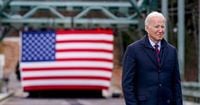It’s a scene that has played out across the country in recent months: motorists pass by bustling construction sites, greeted by bold signs proclaiming, “PRESIDENT DONALD J. TRUMP — REBUILDING AMERICA’S INFRASTRUCTURE.” At first glance, the message is clear. But scratch beneath the surface, and the story becomes decidedly more complicated—and more contentious.
According to The New York Times, these signs have appeared in front of major infrastructure projects from Connecticut to Maryland, and from Seattle to Philadelphia. The projects themselves—bridges, rail yards, and tunnels—are funded by the 2021 Infrastructure Investment and Jobs Act, a $1.2 trillion bipartisan package passed under President Joe Biden. Yet, in a twist that has left many scratching their heads, Donald Trump, who left office in January 2021 and strenuously opposed the bill, is now taking credit for these very projects.
The controversy came to a head on September 9, 2025, when the Democratic National Committee (DNC) released a pointed statement. Rosemary Boeglin, the DNC’s Communications Director, accused Trump of “lying and taking credit for someone else’s work.” She charged, “America is bleeding manufacturing jobs under Donald Trump, and instead of lifting a finger to actually help the American worker, Trump is resorting to his old tricks.” Boeglin’s criticism was rooted in a series of economic reports showing that the U.S. manufacturing sector has hit a rough patch since Trump returned to office.
Data from the Bureau of Labor Statistics, highlighted by Investopedia, shows a loss of 12,000 manufacturing jobs in August 2025 alone—the fourth straight month of decline. Since August 2024, manufacturing employment has dropped by 78,000, reaching its lowest point since March 2022. CNN reported that factory hiring in May had plunged to its weakest rate since 2016, with job openings in the sector falling by nearly 100,000 since Trump took office. The culprit, according to many experts, is the uncertainty sown by Trump’s tariff policies. Betsey Stevenson, a University of Michigan economist, explained, “It’s a policy choice to sow this much uncertainty. And that uncertainty has a cost.”
Despite these economic headwinds, Trump’s administration has doubled down on its efforts to associate his name with infrastructure improvements. Signs bearing “PRESIDENT DONALD J. TRUMP” have been plastered across sites funded by the very legislation he once labeled a “loser for the U.S.A.” When the infrastructure bill passed, Trump warned that Republican lawmakers who supported it could face the wrath of primary voters, declaring, “Patriots will never forget!” Yet, as The New York Times notes, those predictions of political backlash never materialized. In fact, many GOP members who voted against the bill have since boasted about the spending it brought to their districts.
Perhaps the most striking example is the replacement of the 118-year-old Connecticut River Bridge, a $1.3 billion project. Representative Joe Courtney, a Connecticut Democrat, expressed his bewilderment at seeing Trump’s name on the project. “That bridge would never have gotten where it is today without that bill, which he opposed,” Courtney told The New York Times. The pattern repeats elsewhere: infrastructure signs crediting Trump have cropped up in Maryland, Seattle, Boston, Philadelphia, and even at the site of a tunnel replacement on Amtrak’s route between Baltimore and Washington.
Trump’s penchant for claiming credit for Biden-era accomplishments isn’t limited to infrastructure. In July 2025, his administration attempted to claim responsibility for more than $1 trillion in U.S. investments made under Biden. But, as Reuters revealed, nearly half of the spending highlighted by Trump’s team originated under Biden or was routine spending repackaged to appear as new domestic investment. Some projects had already been planned or announced by local officials or companies before Trump took office. Others, Reuters found, were directly aided by Biden’s legislative efforts to boost domestic manufacturing.
This pattern of credit-claiming extends to other policy areas. As MSNBC pointed out, Trump has also sought recognition for reductions in illegal border crossings that occurred before his second inauguration. The contradiction hasn’t gone unnoticed. On the one hand, Trump regularly condemns his predecessor as “the worst president in history.” On the other, he’s quick to tie his name to Biden’s legislative and economic achievements.
The phenomenon isn’t entirely new in American politics. It’s not uncommon for politicians to tout federal investments in their states or districts, even if they voted against the underlying legislation. What sets the current situation apart is both the scale of the projects and the brazenness of the credit claims. As MSNBC observed, “Cynics predicted that the legislation’s Republican opponents, after condemning the effort as Big Government ‘socialism,’ would be only too pleased to take credit for the investments that reached their states and districts. To the surprise of no one, the cynics were correct.”
For many Democrats, the episode is emblematic of a larger issue: the willingness of political leaders to rewrite history in pursuit of electoral advantage. The DNC’s Boeglin summed up the sentiment, stating, “It’s clear once again that Donald Trump is the real loser.” Yet, the Trump administration’s strategy appears calculated to resonate with voters who may be less concerned with legislative details and more focused on visible improvements in their communities.
Meanwhile, the broader economic picture remains mixed. While the Biden-Harris administration presided over a boom in manufacturing and infrastructure jobs, recent months have brought a reversal. The reasons are complex, with factors ranging from global economic shifts to the impact of tariffs and trade policy uncertainty. What’s clear, however, is that the debate over who deserves credit for America’s infrastructure renaissance is far from settled.
As the 2026 election season looms, the battle over infrastructure signs and economic statistics is likely to intensify. For now, the roads and bridges themselves stand as silent witnesses to a political tug-of-war—one where the facts, the funding, and the faces on the signs don’t always tell the same story.

